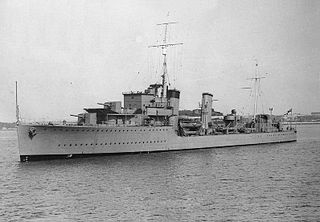Four ships of the Royal Navy have borne the name HMS Kempenfelt, after rear-admiral Richard Kempenfelt:

The Royal Navy (RN) is the United Kingdom's naval warfare force. Although warships were used by the English kings from the early medieval period, the first major maritime engagements were fought in the Hundred Years War against the Kingdom of France. The modern Royal Navy traces its origins to the early 16th century; the oldest of the UK's armed services, it is known as the Senior Service.

Richard Kempenfelt was a British rear admiral who gained a reputation as a naval innovator. He is best known for his victory against the French at the Second Battle of Ushant and for his death when HMS Royal George accidentally sank at Portsmouth the following year.
- HMS Kempenfelt (1915) was a Marksman-class flotilla leader launched in 1915 and sold for scrapping in 1921.
- HMS Kempenfelt (I18) was a C-class destroyer launched in 1931. She was transferred to the Royal Canadian Navy in 1939 and renamed HMCS Assiniboine (I18). She was wrecked in 1945, and the hulk was sold in 1952.
- HMS Kempenfelt (R03) was a W-class destroyer initially named HMS Valentine. She was launched in 1943, sold to the Yugoslav Navy in 1956, where she was named Kotor. She was withdrawn from service in 1971.
- HMS Kempenfelt was the proposed name for the V-class destroyer HMS Valentine, but she was renamed prior to her launch.

HMS Kempenfelt was a Marksman-class flotilla leader of the British Royal Navy. She was built by the Cammell Laird at their Birkenhead shipyard, with construction starting in 1914 and completed in August 1915. She served through the remainder of the First World War. She was sold for scrap in 1921.

A flotilla leader was a warship late of 19th century and early 20th century navies suitable for commanding a flotilla of destroyers or other small warships, typically a small cruiser or a large destroyer. The flotilla leader provided space, equipment and staff for the flotilla commodore, including a wireless room, senior engineering and gunnery officers, and administrative staff to support the officers. Originally, older light or scout cruisers were often used, but in the early 1900s, the rapidly increasing speed of new destroyer designs meant that such vessels could no longer keep pace with their charges. Accordingly, large destroyer designs were produced for use as leaders.

HMS Kempenfelt was a C-class destroyer built for the Royal Navy in the early 1930s. A flotilla leader, she saw service in the Home Fleet before World War II and the ship made several deployments to Spanish waters during the Spanish Civil War, enforcing the arms blockade imposed by Britain and France on both sides of the conflict.
| This article includes a list of ships with the same or similar names. If an internal link for a specific ship led you here, you may wish to change the link to point directly to the intended ship article, if one exists. |

